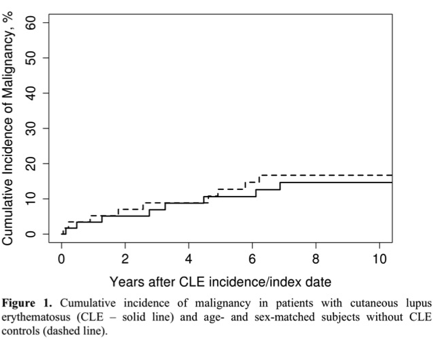Session Information
Session Type: Abstract Submissions (ACR)
Background/Purpose: Systemic immune dysregulation associated with chronic autoimmune diseases such as systemic lupus erythematosus (SLE) as well as immunomodulatory medications used for their treatment have been associated with an increased risk of malignancy. The pathogenesis of cutaneous lupus erythematosus (CLE) is similar to SLE. It is unclear whether CLE is associated with an increased risk of malignancy. Hence, we estimated the cumulative incidence of malignancy in a population-based cohort of patients with CLE, and compared the risk with an age- and sex-matched cohort without CLE.
Methods: Patients with subtypes of CLE (discoid, subacute cutaneous lupus, lupus panniculitis and bullous lupus) were identified from a population-based cohort in 1965-2005. Age- and sex-matched subjects without CLE were selected from the same population. Non-CLE subjects were assigned an index date corresponding to the CLE diagnosis date of the matched CLE patient. For a random sample of 66 of the 156 patients with CLE and the non-CLE subjects matched to them, data were collected on all cancers via medical record review. The cumulative incidence of cancer after CLE diagnosis was estimated using Kaplan–Meier methods. Cox models were used to estimate the relative risk of malignancy in patients with CLE as compared to non-CLE adjusted for age, sex and calendar year of index date.
Results: We identified 66 patients with CLE (mean age at time of CLE diagnosis, 55±14y; 64% females; 68% Caucasian; mean BMI, 27.3±7.2 kg/m2; 34.8% smokers), who were followed over a median follow-up of 12.0 years (interquartile range [IQR], 8.1-17.3y). Positive antinuclear antibody, anti-SSA and anti-SSB were seen in 48%, 47% and 18% of patients with CLE, respectively. Median ESR was 11 mm/hour (IQR, 4.0-25.0) and CRP 2.9 mg/dL (IQR 1.5-3.9). Overall, we observed 14 cases of incident cancer (including 5 cases of non-melanoma skin cancer). The cumulative 1-, 5- and 10-year incidence of any malignancy after diagnosis of CLE was 3.4%, 10.9% and 14.6%, respectively. As compared to age- and sex-matched non-CLE controls, the overall risk of malignancies was not increased in patients with CLE (hazard ratio [HR], 1.09; 95% CI, 0.51-2.37; p=0.81) (Figure 1). The cumulative 1-, 5- and 10-year incidence of all malignancies except non-melanoma skin cancers in patients with CLE was 1.7%, 7.1% and 11.1%, respectively. As compared to matched controls, the risk of all malignancies except non-melanoma skin cancer in patients with CLE was not increased (HR, 0.88; 95% CI, 0.36-2.14; p=0.78).
Conclusion: The 10-year risk of any malignancy in a population-based cohort of patients with CLE is 14.6%. This risk is not increased as compared to age- and sex-matched subjects without CLE.
Disclosure:
A. G. Singh,
None;
C. S. Crowson,
None;
M. Davis,
None;
H. Maradit Kremers,
None;
E. L. Matteson,
None;
V. Chowdhary,
None.
« Back to 2014 ACR/ARHP Annual Meeting
ACR Meeting Abstracts - https://acrabstracts.org/abstract/risk-of-cancer-is-not-increased-in-patients-with-cutaneous-lupus-erythematosus-a-population-based-study/

